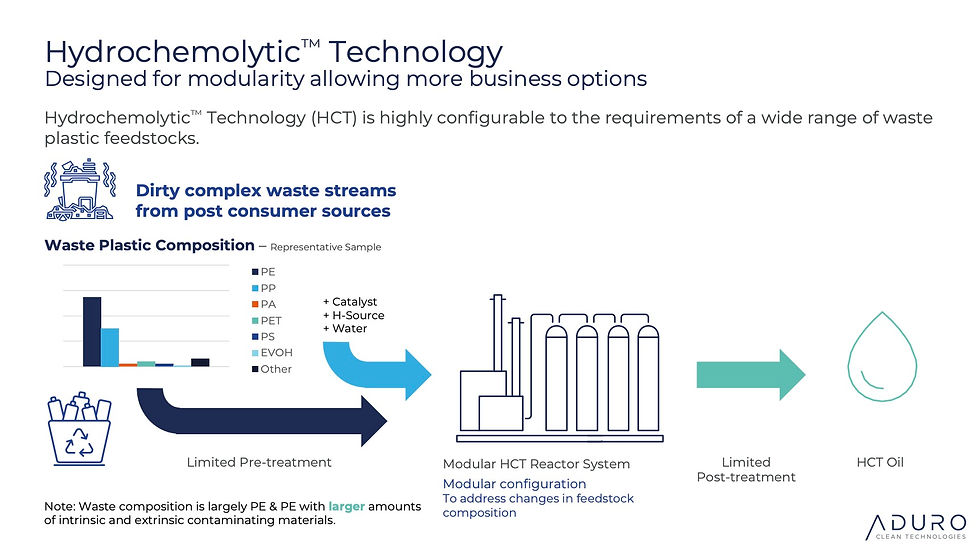A Chemical Recycling Pathway for Synthetic Turf Waste
- mltanalytics
- Aug 11
- 2 min read
Aduro Clean Technologies Inc. has completed successful initial testing of synthetic turf as a feedstock for its proprietary Hydrochemolytic Technology (HCT). In recent months, Aduro tested samples of synthetic turf waste, commonly used in sports stadiums and landscaping with encouraging results. The HCT process uses a catalyst, a hydrogen source and watee to break down polymers contained in dirty complex waste streams under less severe conditions compared with pyrolysis.
The samples reflected the typical multilayer structure of modern synthetic turf systems, including polyethylene (PE) grass blades, polypropylene (PP) thatch layers, primary and secondary PP backing layers, residual infill materials such as silica sand and crumb rubber and polyurethane adhesives used to secure the backing and fibers. This complex composition, which combines multiple plastics, thermoset adhesives, and inorganic materials, poses challenges for mechanical recycling and limits compatibility with conventional chemical recycling methods that rely on cleaner, more uniform input streams.

Feedstock conversion
Testing showed that Aduro’s chemical recycling process selectively converted the polyolefin components of the turf into shorter-chain hydrocarbon products, which are relevant as potential feedstocks for steam cracking and new polymer production. This was achieved without extensive preprocessing, as the process demonstrated tolerance for the mixed materials and contaminants typically present in aged turf systems. These outcomes contribute to ongoing efforts to evaluate the applicability of Hydrochemolytic™ Technology to complex waste streams that are not readily addressed by conventional recycling methods.
As part of this initiative, the Company received synthetic turf samples from a global industry stakeholder for evaluation. Several other parties have expressed interest in the results, underscoring the growing demand for chemical recycling options in this segment.
“This trial supports our strategy of targeting market segments that are underserved by conventional recycling, either due to complex material composition or limited processing scale,” said Ofer Vicus, CEO of Aduro. “Synthetic turf is a good example—its multilayer construction, bonded components, and contamination make it difficult to process through traditional means. These are the kinds of waste streams that may be better suited to right-sized, modular chemical recycling systems like HCT.”
End of life approaching across North America
Synthetic turf is widely used around the world in applications such as sports fields, landscaping, playgrounds, road medians, commercial rooftops, and indoor training facilities, due to its durability and low maintenance requirements. A single full-sized field can weigh between 200 and 300 tonbes, and in North America, more than 12,000 fields are expected to reach end of their service life within the next five years. While manufacturers and recyclers have introduced take-back programs and material reuse strategies, these efforts are often constrained by technical and economic limitations. According to HTF Market Intelligence, the synthetic turf recycling market is expected to grow from USD 1.8 billion in 2025 to approximately USD 5.9 billion by 2032, with a compound annual growth rate (CAGR) of ~15.8%.
Beyond artificial turf, carpets represent a similarly complex and under-addressed waste stream. The World Economic Forum notes that the textile industry generates approximately 92 million tons of waste globally each year, a significant portion of which comes from flooring and carpet products. While carpet is not currently part of Aduro’s testing activities, the material’s recovery challenges suggest it could be a future candidate for modular, scalable chemical recycling.



Comments